Question
(a) Define the term chemical digestion
(b) A student investigated the activity of the digestive enzyme pepsin.
Fig. 6.1 shows the apparatus used in the investigation.
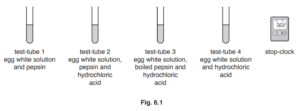
The appearance of the four test-tubes was recorded at 0 and 5 minutes.
The protein in the egg white solution gives the solution a cloudy appearance.
The cloudy appearance clears when the protein in the egg white solution breaks down.
Table 6.1 shows the results.
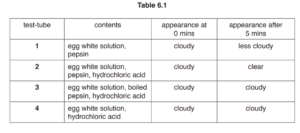
(i) Explain the results shown for test-tubes 1, 2 and 3 in Table 6.1.
(ii) Explain the purpose of test-tube 4.
(iii) State the name of the organ in the body that produces pepsin.
(c) Maltase is another digestive enzyme.
Describe the action of maltase and state where it acts in the alimentary canal.
Answer/Explanation
Ans
6 (a) breakdown of large to small molecules ;
from insoluble to soluble ;
6 (b) (i) test-tube 1
1 (less cloudy), slower break down of egg white solution / protein ;
2 (no HCl so) pH of the solution is too high ; ora
3 high pH denatures pepsin / enzyme ;
test-tube 2
4 hydrochloric acid causes a low pH ;
5 pepsin works best in / optimal activity, low pH / acidic conditions ;
test-tube 3
6 pepsin / enzyme, unable to break down, protein / egg white solution ;
7 boiling denatures, pepsin / enzyme ;
8 ref to enzyme-substrate complex / fewer successful collisions ;
9 high pH / boiling, changes shape of active site ;
6 (b) (ii) as a control ;
to show that pepsin is responsible for the protein digestion ;
to show that hydrochloric acid does not digest the protein ;
6 (b) (iii) stomach ;
6 (c) maltose broken down ;
to glucose ;
on the membranes of the epithelial lining ;
(acts) in the small intestine / duodenum ;
Question
Fig. 7.1 shows the human alimentary canal and some of the organs associated with it.

(a) Use letters from Fig. 7.1 to identify which structure carries out a particular function. Write your answers in Table 7.1.
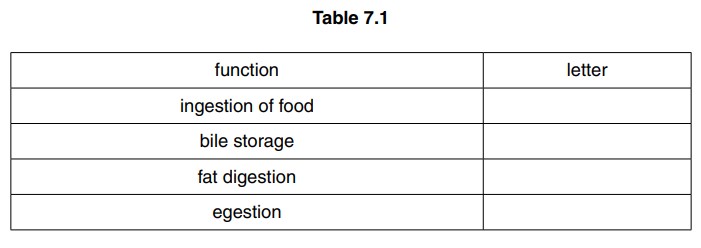
(b) Name the process which moves food from D to F.
…………………………………………………………………………………………………………………………….
(c) A student investigated the digestion of fats by the enzyme lipase. He found that as lipase digested the fats, the pH of the solution changed from pH 8 to pH 6.
(i) Explain why the digestion of fats changed the pH of the solution.
………………………………………………………………………………………………………………………….
………………………………………………………………………………………………………………………….
………………………………………………………………………………………………………………………….
………………………………………………………………………………………………………………………….
(ii) Fig. 7.2 shows three test-tubes that were set up for this experiment.
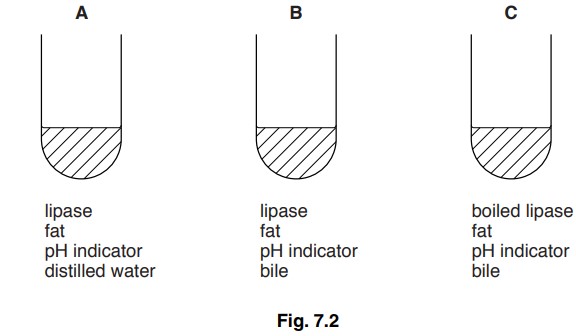
The time taken for the indicator to change colour after the lipase was added was measured. The results are shown in Table 7.2.
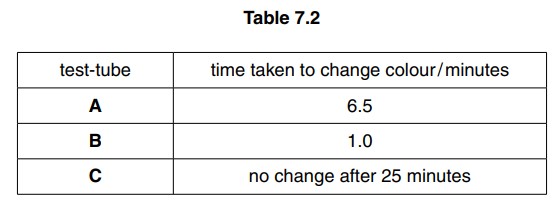
Explain why the indicator in test-tube B changes colour much faster than the indicator in test-tube A.
………………………………………………………………………………………………………………………….
………………………………………………………………………………………………………………………….
………………………………………………………………………………………………………………………….
………………………………………………………………………………………………………………………….
………………………………………………………………………………………………………………………….
……………………………………………………………………………………………………………………..
(d) Some biological washing powders contain lipase. Instructions on the packet state that biological washing powders should be used in warm water but not in very hot water. Explain why warm water should be used instead of very hot water. Use Fig. 7.2 and Table 7.2 to help with your answer.
…………………………………………………………………………………………………………………………………
…………………………………………………………………………………………………………………………………
…………………………………………………………………………………………………………………………………
………………………………………………………………………………………………………………………………….
(e) Eating too much fat can be harmful. State one way in which too much fat can be harmful to human health.
…………………………………………………………………………………………………………………………………………………………….
Answer/Explanation
Ans:
(a) 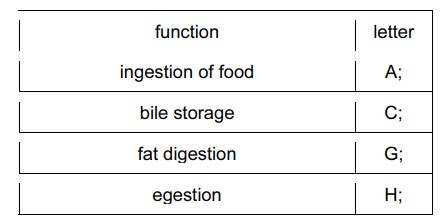
(b) peristalsis;
(c) (i) fat digestion produces fatty acids (and glycerol);
fatty acids lower pH;
(ii) (B contains bile) which emulsifies fats;
increases surface area for enzyme/ lipase action/AW;
(so) fatty acids are produced more quickly / more rapid fat digestion;
colour of indicator changes more quickly;
(d) hot water could denature the enzyme;
changes the shape of active site of enzyme/ enzyme
inactive;
tube C shows that boiled enzyme does not digest fats;
(e) obesity;
(which) leads to joint damage;
blockage of blood vessels / heart disease/CHD/atherosclerosis / cardiac arrest;
high blood pressure;
type 2 diabetes;
cancer;
AVP;
